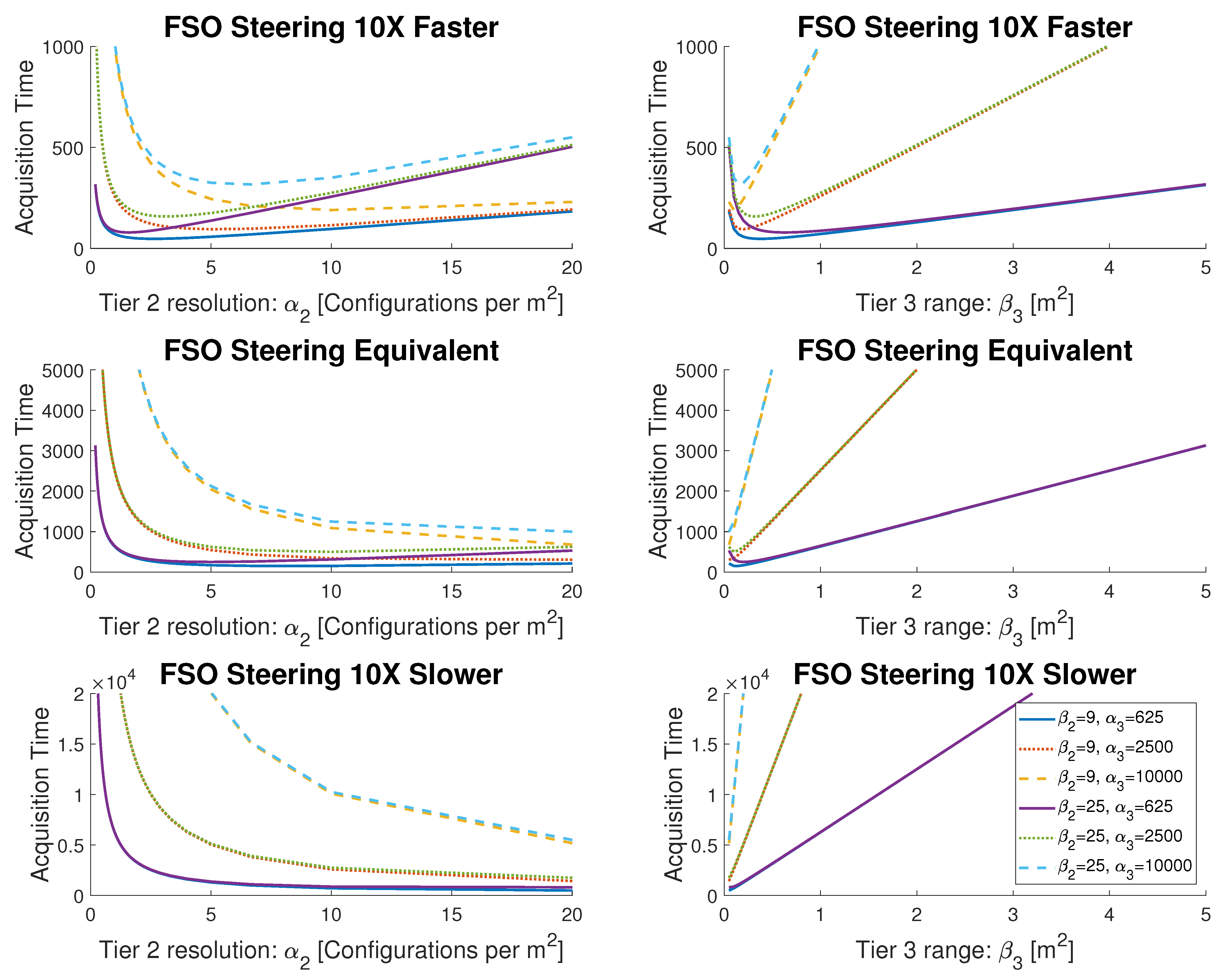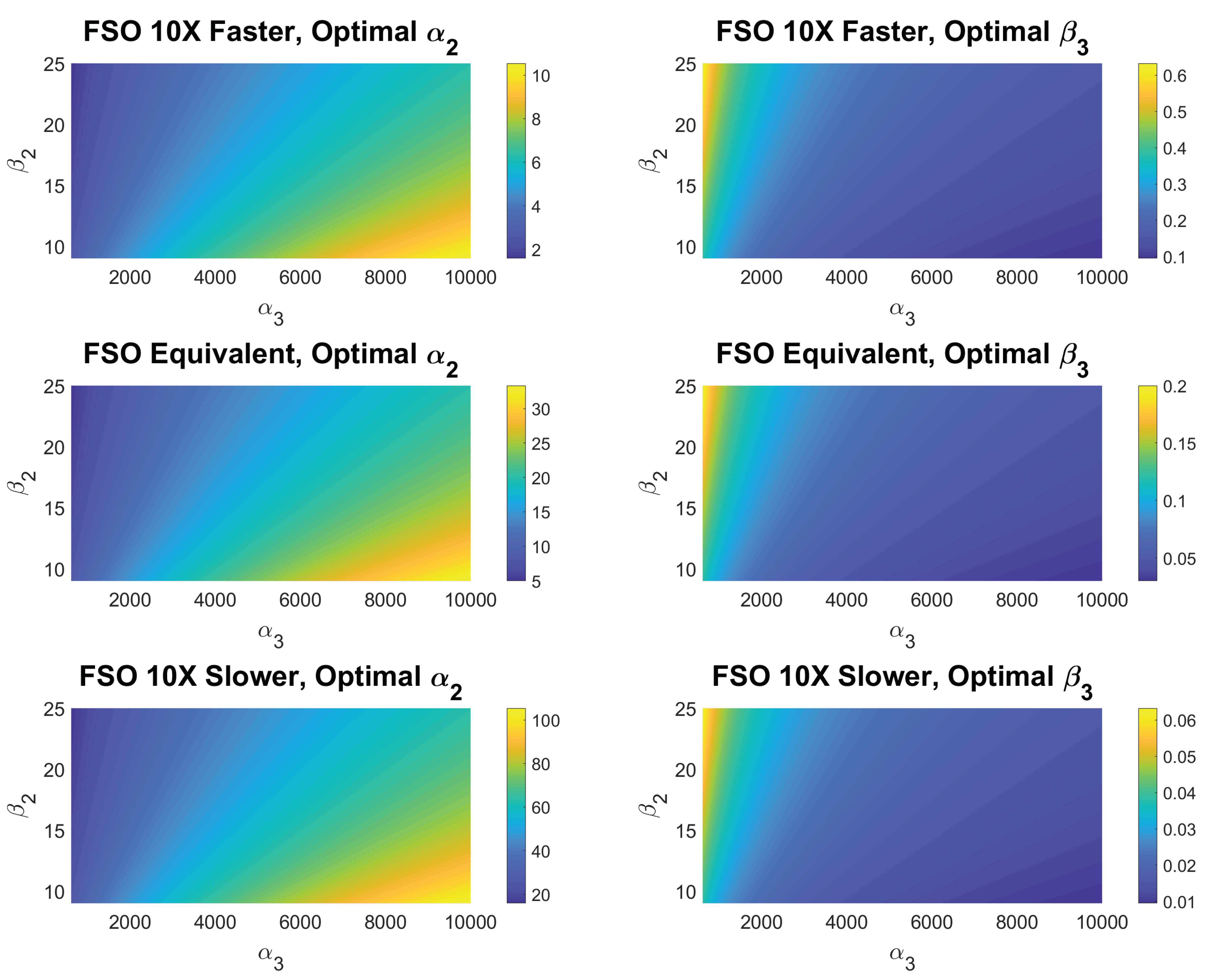Multi-Tier Heterogeneous Beam Management for Future Indoor FSO Networks
Abstract
Featured Application
Abstract
1. Introduction
- A detailed description of the MTH beam management strategy including key requirements for pointing/acquisition/tracking, multi-tier beam refinement, heterogeneous beam management, and configuration/deployment of the system
- A foundational analysis framework that offers a qualitative visualization of relative performance in terms of coverage, resolution, and steering velocity across tiers
- An optimization analysis to define the top tier resolution that minimizes worst-case search time as a function of lower tier resolution and top tier range
2. Background and Motivation
2.1. Background and Existing Literature
2.2. System View
3. MTH Beam Management Protocol
3.1. Pointing, Acquisition, and Tracking (PAT)
3.2. Multi-Tier Beam Refinement
3.3. Beam Management
3.4. Zone Configuration
4. Analysis Framework
5. Results and Analysis
6. Conclusions
Author Contributions
Funding
Data Availability Statement
Conflicts of Interest
References
- Petrov, V.; Moltchanov, D.; Koucheryavy, Y. On the Efficiency of Spatial Channel Reuse in Ultra-Dense THz Networks. In Proceedings of the 2015 IEEE Global Communications Conference (GLOBECOM), San Diego, CA, USA, 6–10 December 2015; pp. 1–7. [Google Scholar] [CrossRef]
- Perez, J.; Chicharro, F.I.; Ortega, B.; Mora, J. On the evaluation of an optical OFDM radio over FSO system with IM-DD for high-speed indoor communications. In Proceedings of the 2017 19th International Conference on Transparent Optical Networks (ICTON), Girona, Spain, 2–6 July 2017; pp. 1–4. [Google Scholar] [CrossRef]
- Boulogeorgos, A.A.; Goudos, S.K.; Alexiou, A. Users Association in Ultra Dense THz Networks. In Proceedings of the 2018 IEEE 19th International Workshop on Signal Processing Advances in Wireless Communications (SPAWC), Kalamata, Greece, 25–28 June 2018; pp. 1–5. [Google Scholar] [CrossRef]
- Calvanese Strinati, E.; Barbarossa, S.; Gonzalez-Jimenez, J.L.; Ktenas, D.; Cassiau, N.; Maret, L.; Dehos, C. 6G: The Next Frontier: From Holographic Messaging to Artificial Intelligence Using Subterahertz and Visible Light Communication. IEEE Veh. Technol. Mag. 2019, 14, 42–50. [Google Scholar] [CrossRef]
- Sarkar, T.S.; Sinha, B.; Mukherjee, S.; Joardar, I.; Mazumdar, S. Development of an FPGA based Indoor Free Space Optical (FSO) Communication System using 808 nm Infrared (IR) LASER Source. In Proceedings of the 2020 IEEE Calcutta Conference (CALCON), Kolkata, India, 28–29 February 2020; pp. 313–317. [Google Scholar] [CrossRef]
- Gomez, A.; Shi, K.; Quintana, C.; Maher, R.; Faulkner, G.; Bayvel, P.; Thomsen, B.C.; Obrien, D. Design and Demonstration of a 400 Gb/s Indoor Optical Wireless Communications Link. J. Light. Technol. 2016, 34, 5332–5339. [Google Scholar] [CrossRef]
- O’Hara, J.F.; Ekin, S.; Choi, W.; Song, I. A Perspective on Terahertz Next-Generation Wireless Communications. Technologies 2019, 7, 43. [Google Scholar] [CrossRef]
- Aghasi, H.; Naghavi, S.; Tavakoli Taba, M.; Aseeri, M.; Cathelin, A.; Afshari, E. Terahertz electronics: Application of wave propagation and nonlinear processes. Appl. Phys. Rev. 2020, 7, 021302. [Google Scholar] [CrossRef]
- Tonkikh, E.V.; Burobina, K.D.; Shurakhov, A.A. Possible Applications of Sixth Generation Communication Networks. In Proceedings of the 2020 Systems of Signals Generating and Processing in the Field of on Board Communications, Moscow, Russia, 19–20 March 2020; pp. 1–6. [Google Scholar] [CrossRef]
- Firyaguna, F.; Kibilda, J.; Galiotto, C.; Marchetti, N. Coverage and Spectral Efficiency of Indoor mmWave Networks with Ceiling-Mounted Access Points. In Proceedings of the GLOBECOM 2017-2017 IEEE Global Communications Conference, Singapore, 4–8 December 2017; pp. 1–7. [Google Scholar] [CrossRef]
- Chowdhury, M.Z.; Hossan, M.T.; Islam, A.; Jang, Y.M. A Comparative Survey of Optical Wireless Technologies: Architectures and Applications. IEEE Access 2018, 6, 9819–9840. [Google Scholar] [CrossRef]
- Chowdhury, M.Z.; Hasan, M.K.; Shahjalal, M.; Hossan, M.T.; Jang, Y.M. Optical Wireless Hybrid Networks: Trends, Opportunities, Challenges, and Research Directions. IEEE Commun. Surv. Tutor. 2020, 22, 930–966. [Google Scholar] [CrossRef]
- Li, J.; Li, R.; Rahaim, M.B. Design and Implementation of a Heterogeneous Multi-Hop OWC/RF Relay Architecture for Opportunistic Ultra-Dense Wireless Networks. In Proceedings of the 2020 11th IEEE Annual Ubiquitous Computing, Electronics Mobile Communication Conference (UEMCON), New York, NY, USA, 28–31 October 2020; pp. 0684–0689. [Google Scholar] [CrossRef]
- Gomez, A.; Shi, K.; Quintana, C.; Faulkner, G.; Thomsen, B.C.; O’Brien, D. A 50 Gb/s Transparent Indoor Optical Wireless Communications Link With an Integrated Localization and Tracking System. J. Light. Technol. 2016, 34, 2510–2517. [Google Scholar] [CrossRef]
- Fahs, B.; Chowdhury, A.J.; Hella, M.M. A 12-m 2.5-Gb/s Lighting Compatible Integrated Receiver for OOK Visible Light Communication Links. J. Light. Technol. 2016, 34, 3768–3775. [Google Scholar] [CrossRef]
- Fahs, B.; Romanowicz, M.; Hella, M.M. A Gbps Building-to-Building VLC Link Using Standard CMOS Avalanche Photodiodes. IEEE Photonics J. 2017, 9, 1–9. [Google Scholar] [CrossRef]
- Fahs, B.; Hella, M.M. 3 Gb/s OOK VLC link using bandwidth-enhanced CMOS Avalanche photodiode. In Optical Fiber Communications Conference and Exhibition (OFC); Optical Society of America: Washington, DC, USA, 2017; pp. 1–3. [Google Scholar]
- Oh, C.W.; Cao, Z.; Tangdiongga, E.; Koonen, T. Free-space transmission with passive two-dimensional beam steering for indoor optical wireless networks. Opt. Express 2017, 24, 19211–19227. [Google Scholar] [CrossRef]
- Rahaim, M.; Morrison, J.; Little, T. Beam Control for Indoor FSO and Dynamic Dual-Use VLC Lighting Systems. J. Commun. Inf. Netw. 2017, 2. [Google Scholar] [CrossRef]
- Koonen, T. Indoor Optical Wireless Systems: Technology, Trends, and Applications. J. Light. Technol. 2018, 36, 1459–1467. [Google Scholar] [CrossRef]
- Abdalla, I.; Rahaim, M.B.; Little, T.D.C. Dynamic FOV Tracking Receiver for Dense Optical Wireless Networks. In Proceedings of the 2019 IEEE Global Communications Conference (GLOBECOM), Waikoloa, HI, USA, 9–13 December 2019; pp. 1–6. [Google Scholar] [CrossRef]
- Abdalla, I.; Rahaim, M.B.; Little, T.D.C. Interference Mitigation Through User Association and Receiver Field of View Optimization in a Multi-User Indoor Hybrid RF/VLC Illuminance-Constrained Network. IEEE Access 2020, 8, 228779–228797. [Google Scholar] [CrossRef]
- Attiah, M.L.; Isa, A.A.M.; Zakaria, Z.; Abdulhameed, M.; Mohsen, M.K.; Ali, I. A survey of mmWave user association mechanisms and spectrum sharing approaches: An overview, open issues and challenges, future research trends. Wirel. Netw. 2020, 26, 2487–2514. [Google Scholar] [CrossRef]
- Ayyash, M.; Elgala, H.; Khreishah, A.; Jungnickel, V.; Little, T.; Shao, S.; Rahaim, M.; Schulz, D.; Hilt, J.; Freund, R. Coexistence of WiFi and LiFi toward 5G: Concepts, opportunities, and challenges. IEEE Commun. Mag. 2016, 54, 64–71. [Google Scholar] [CrossRef]
- Rahaim, M.B.; Little, T.D.C. Toward practical integration of dual-use VLC within 5G networks. IEEE Wirel. Commun. 2015, 22, 97–103. [Google Scholar] [CrossRef]
- Rahaim, M.; Abdalla, I.; Ayyash, M.; Elgala, H.; Khreishah, A.; Little, T.D.C. Welcome to the CROWD: Design Decisions for Coexisting Radio and Optical Wireless Deployments. IEEE Netw. 2019, 1–9. [Google Scholar] [CrossRef]
- Yuan, F.; Yang, C.; Wang, G.; Lei, M. Adaptive Channel Feedback for Coordinated Beamforming in Heterogeneous Networks. IEEE Trans. Wirel. Commun. 2013, 12, 3980–3994. [Google Scholar] [CrossRef]
- Tataria, H.; Shafi, M.; Smith, P.J.; Dmochowski, P.A. Coordinated two-tier heterogeneous cellular networks with leakage based beamforming. arXiv 2015, arXiv:1503.01566. [Google Scholar]
- Peng, H.; Moriwaki, K.; Suegara, Y. Macro-Controlled Beam Database-Based Beamforming Protocol for LTE-WiGig Aggregation in Millimeter-Wave Heterogeneous Networks. In Proceedings of the 2016 IEEE 83rd Vehicular Technology Conference (VTC Spring), Nanjing, China, 15–18 May 2016; pp. 1–6. [Google Scholar] [CrossRef]
- Wang, F.; Chen, W.; Wu, Q.; Tang, H. Robust MISO Beamforming Under the Deterministic Model in Two-Tier Heterogeneous Networks. IEEE Access 2017, 5, 14616–14625. [Google Scholar] [CrossRef]
- Hefnawi, M. Hybrid Beamforming for Millimeter-Wave Heterogeneous Networks. Electronics 2019, 8, 133. [Google Scholar] [CrossRef]
- Ha, D.T.; Boukhatem, L.; Kaneko, M.; Martin, S. An Advanced Mobility-Aware Algorithm for Joint Beamforming and Clustering in Heterogeneous Cloud Radio Access Network. In Proceedings of the 21st ACM International Conference on Modeling, Analysis and Simulation of Wireless and Mobile Systems, New York, NY, USA, 25 October 2018; pp. 199–206. [Google Scholar] [CrossRef]
- Tabassum, H.; Salehi, M.; Hossain, E. Fundamentals of Mobility-Aware Performance Characterization of Cellular Networks: A Tutorial. IEEE Commun. Surv. Tutor. 2019, 21, 2288–2308. [Google Scholar] [CrossRef]
- Dastgheib, M.A.; Beyranvand, H.; Salehi, J.A.; Maier, M. Mobility-Aware Resource Allocation in VLC Networks Using T-Step Look-Ahead Policy. J. Light. Technol. 2018, 36, 5358–5370. [Google Scholar] [CrossRef]
- Wu, X.; Haas, H. Mobility-aware load balancing for hybrid LiFi and WiFi networks. J. Opt. Commun. Netw. 2019, 11, 588–597. [Google Scholar] [CrossRef]
- Giordani, M.; Polese, M.; Roy, A.; Castor, D.; Zorzi, M. A Tutorial on Beam Management for 3GPP NR at mmWave Frequencies. IEEE Commun. Surv. Tutor. 2019, 21, 173–196. [Google Scholar] [CrossRef]
- Nor, A.M.; Mohamed, E.M. Millimeter Wave Beamforming Training Based on Li-Fi Localization in Indoor Environment. In Proceedings of the GLOBECOM 2017-2017 IEEE Global Communications Conference, Singapore, 4–8 December 2017; pp. 1–6. [Google Scholar] [CrossRef]
- Maletic, N.; Sark, V.; Gutiérrez, J.; Grass, E. Device Localization Using mmWave Ranging with Sub-6-Assisted Angle of Arrival Estimation. In Proceedings of the 2018 IEEE International Symposium on Broadband Multimedia Systems and Broadcasting (BMSB), Valencia, Spain, 6–8 June 2018; pp. 1–6. [Google Scholar] [CrossRef]
- Haider, M.K.; Ghasempour, Y.; Koutsonikolas, D.; Knightly, E.W. LiSteer: MmWave Beam Acquisition and Steering by Tracking Indicator LEDs on Wireless APs. In Proceedings of the 24th Annual International Conference on Mobile Computing and Networking (MobiCom ’18), New Delhi, India, 29 October–2 November 2018; pp. 273–288. [Google Scholar] [CrossRef]
- Fahs, B.; Romanowicz, M.; Kim, J.; Hella, M.M. A Self-Alignment System for LOS Optical Wireless Communication Links. IEEE Photonics Technol. Lett. 2017, 29, 2207–2210. [Google Scholar] [CrossRef]








| Parameter | Description |
|---|---|
| Maximum Search Time | |
| Discovery Time (Tier 1) | |
| Configuration Switching Time (Tier i) | |
| Number of Configurations (Tier i) | |
| Tier i Resolution [configurations/] | |
| Tier i Range [] |
Publisher’s Note: MDPI stays neutral with regard to jurisdictional claims in published maps and institutional affiliations. |
© 2021 by the authors. Licensee MDPI, Basel, Switzerland. This article is an open access article distributed under the terms and conditions of the Creative Commons Attribution (CC BY) license (https://creativecommons.org/licenses/by/4.0/).
Share and Cite
Rahaim, M.B.; Little, T.D.C.; Hella, M. Multi-Tier Heterogeneous Beam Management for Future Indoor FSO Networks. Appl. Sci. 2021, 11, 3627. https://doi.org/10.3390/app11083627
Rahaim MB, Little TDC, Hella M. Multi-Tier Heterogeneous Beam Management for Future Indoor FSO Networks. Applied Sciences. 2021; 11(8):3627. https://doi.org/10.3390/app11083627
Chicago/Turabian StyleRahaim, Michael B., Thomas D. C. Little, and Mona Hella. 2021. "Multi-Tier Heterogeneous Beam Management for Future Indoor FSO Networks" Applied Sciences 11, no. 8: 3627. https://doi.org/10.3390/app11083627
APA StyleRahaim, M. B., Little, T. D. C., & Hella, M. (2021). Multi-Tier Heterogeneous Beam Management for Future Indoor FSO Networks. Applied Sciences, 11(8), 3627. https://doi.org/10.3390/app11083627






